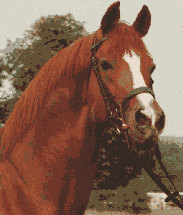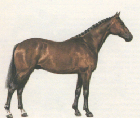|
|
 |
The Kisber Felver
 |
The Kisbér Félvér breed was
developed at the former Kisbér Stud in Hungary. The Stud farm was formed
in 1853 on 15,000 acres. It was developed primarily for the breeding of
Thoroughbred horses. The Stud produced such racing talents as Kisbér,
winner of the Epsom Derby; and Kincsem, the unbeatable mare who made
her way to the Guinness Book of World Records for an unbeaten 54 races.
The Kisbér Stud not only left permanent marks on Thoroughbred racing
history, but also developed a half-bred horse that was regarded as 'The
World's Most Beautiful Sport Horse'.
Thorough a carefully planned
and controlled breeding program, rigorous in its selection process, a distinct
type evolved. The early Thoroughbred stallions who helped to develop the modern
breed were Fenek ( Buccaneer- Helen Triomphante),
|
 |
Filou ( Gunnarsbury- Fidget), Dunure (St.Simon-
Sunrise), Maxim (St.Maclaou-Crested Gable) and Honpolgar (Duncan
Grey-Short Holiday). These of course are only a partial list of the
influential Thoroughbred stallions, but are among the existing sire lines.
Another major influence on the breed was the Trakehner stallions Szeplak
(Templehüter-Héldenlégende) and Formas (Lancealot xx
- Foramint)
 |
These modern Hungarian horses
clearly display the traits that we desire in the sport horse: conformation,
athletic ability, movement, and temperament.
Few countries have experienced the turmoil of war as often as Hungary. Each
invasion left its mark on the horses. Unfortunately, the two World Wars nearly
destroyed them. In 1945, more than half of the Studs breeding stock was taken
as 'war booty'. |
Many were adopted by other
breeds to use as improvement stock. A very famous example of this is
Brunus, a Trakehner stallion who carries not one drop of Trakehner
blood, but is in fact a classically bred Kisbér Félvér.
150 Kisbér Félvér horses were imported for the US
Remount. Unlike the romantic and yet similar story of the Lippizaners,
these horses were never returned home. When the remount disbanded in 1947, the
horses were sold at public auction. Only a handful of people understood the
true value of these horses and only through their diligence and passion for
these 'Heavenly Horses' do they remain in North America. Efforts are
being made on two continents to save this breed. A critically endangered breed,
there are less than 2000 Kisbér Félvér horses in the
world.
The KGA/NA is working in collaboration with other
like minded bodies to increase the population and maintain existing lines.
Selection is directed towards maintaining a uniform type worldwide with
serviceability for sports purposes. Candidate breeding stallions must pass a
work capacity test. Only those individuals passing may by used for breeding.
Kisber Felver stallions are also tested by the performance of their progeny,
and in this way a continually improving breed is developed
 |
Over the course of two hundred
years the Hungarian Government pursued an aggressive breeding program with the
goal of producing a superior Calvary horse. Towards that end, they selectively
crossed the sturdy, nearly indestructible native Hungarian horse with the
finest Thoroughbred and Arabians. |
Continuing to introduce the
Thoroughbred and occasionally the Arabian and Trakehner they have achieved this
goal. A medium sized horse with good ground covering movement, a big boned
Thoroughbred conformation and calm temperament. It is a lively but kind horse
and possess the depth of stamina and toughness for which its ancestors were
noted. Generally you find the Kisbér Félvér to be a very
people oriented horse, extremely intelligent and willing to please. They are
inquisitive and courageous, and so they are easily trained. Sizes range 15.3 to
17.0 hands. All solid colors including palomino and buckskin.
Accepted Crosses to Kisbér Félvér:
Thoroughbred, Trakehner, Selle Francais, Anglo-Arabian, Arabian, and Shagya
Arabian. With a documented pedigree of four [4] generations. Minimum size
requirement of 15.2 [ 157 cm]. These breeds may be registered and branded
as Foundation stock. Crossed to Approved or Licensed breeding stock the
offspring will be registered in the Kisber Felver Studbook and saddle place
branded.
| The information and
photographs in this article are kindly provided by the Kisber Felver &
Gidran Association of North America. For further information on this breed,
please click here. |
 |
|

